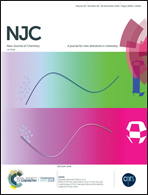Deciphering the mechanism of copper-catalyzed N-arylation between aryl halides and nitriles: a DFT study†
Abstract
The mechanism of the CuI/DMEDA-catalyzed tandem hydrolysis/N-arylation of benzonitrile with aryl iodide was studied using the DFT method. Two possible copper complexes, Int1 [CuI(DMEDA)] and Int2 (anionic analogue of Int1), were investigated for four plausible reaction pathways involved in the hydrolysis of benzonitrile. In paths A and C, the iodide ligand of Int1 and Int2 needs to be replaced with a hydroxide ion to give hydroxide-coordinated intermediates Int1-1 and Int2-1, which can eventually react with benzonitrile to hydrolyze their nitrile group to yield intermediates Int1-3 and Int2-3, respectively. In contrast, the iodide ligand can initially be replaced by benzonitrile to form benzonitrile-coordinated intermediates Int1-2 and Int2-2 (described in paths B and D), which react with the hydroxide ion to hydrolyze the nitrile group of the coordinated benzonitrile ligand to give Int1-3 and Int2-3, respectively. The intrinsic reaction coordinate (IRC) analysis of the transition states involved in the hydrolysis validated paths A and C. The activation energy and overall energy barrier for path A (25.9 and 10.6 kcal mol−1) is lower than that for path C (27.5 and 19.7 kcal mol−1), respectively. Intermediate Int1-3 tautomerizes to give intermediate Int1-4, which undergoes C–N coupling reaction with iodobenzene via an oxidative addition/reductive elimination mechanism. The hydrolysis of the nitrile group was proven to be the rate-limiting step since it has a higher activation energy (25.9 kcal mol−1) than that of the oxidative addition (22.9 kcal mol−1) and reductive elimination reactions (6.9 kcal mol−1).



 Please wait while we load your content...
Please wait while we load your content...